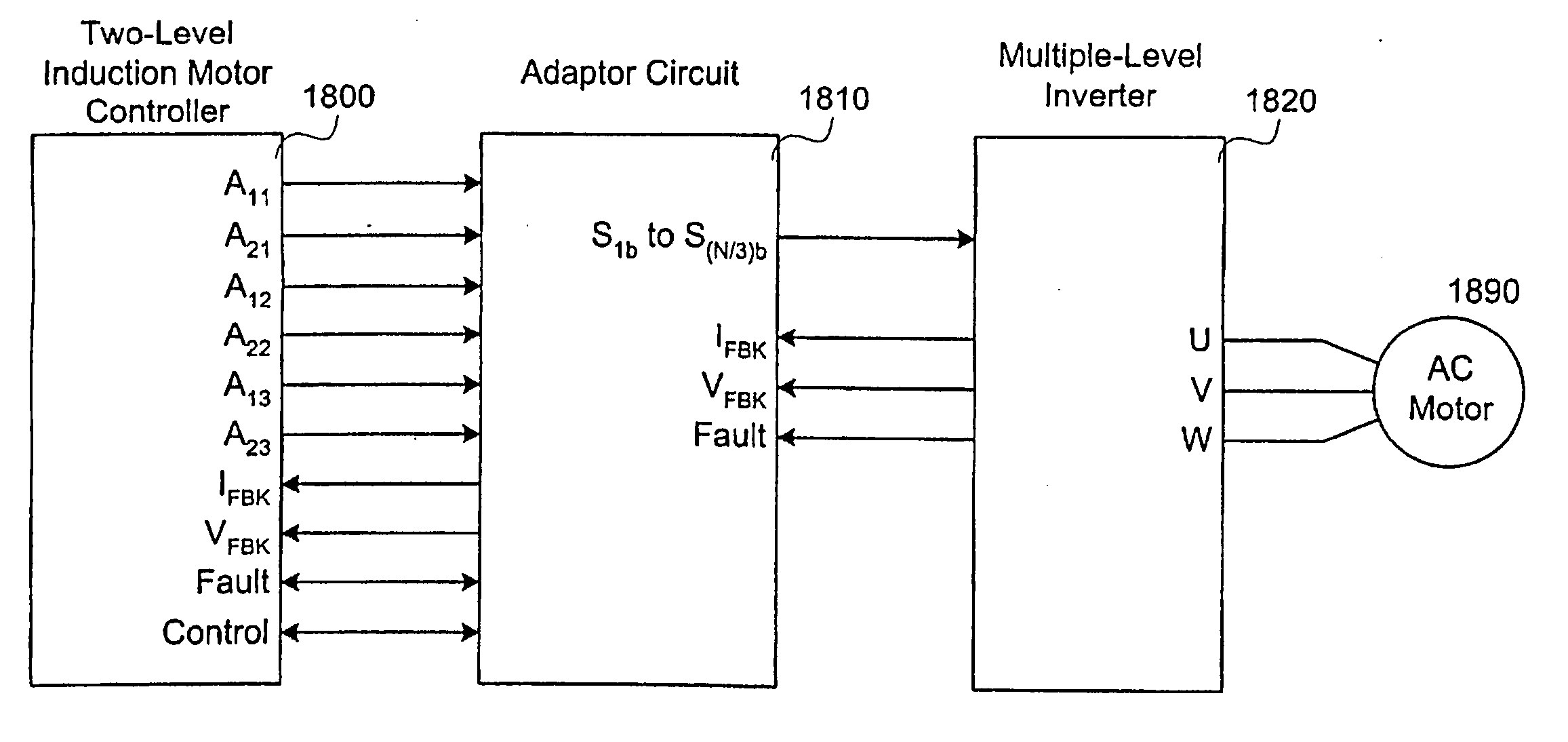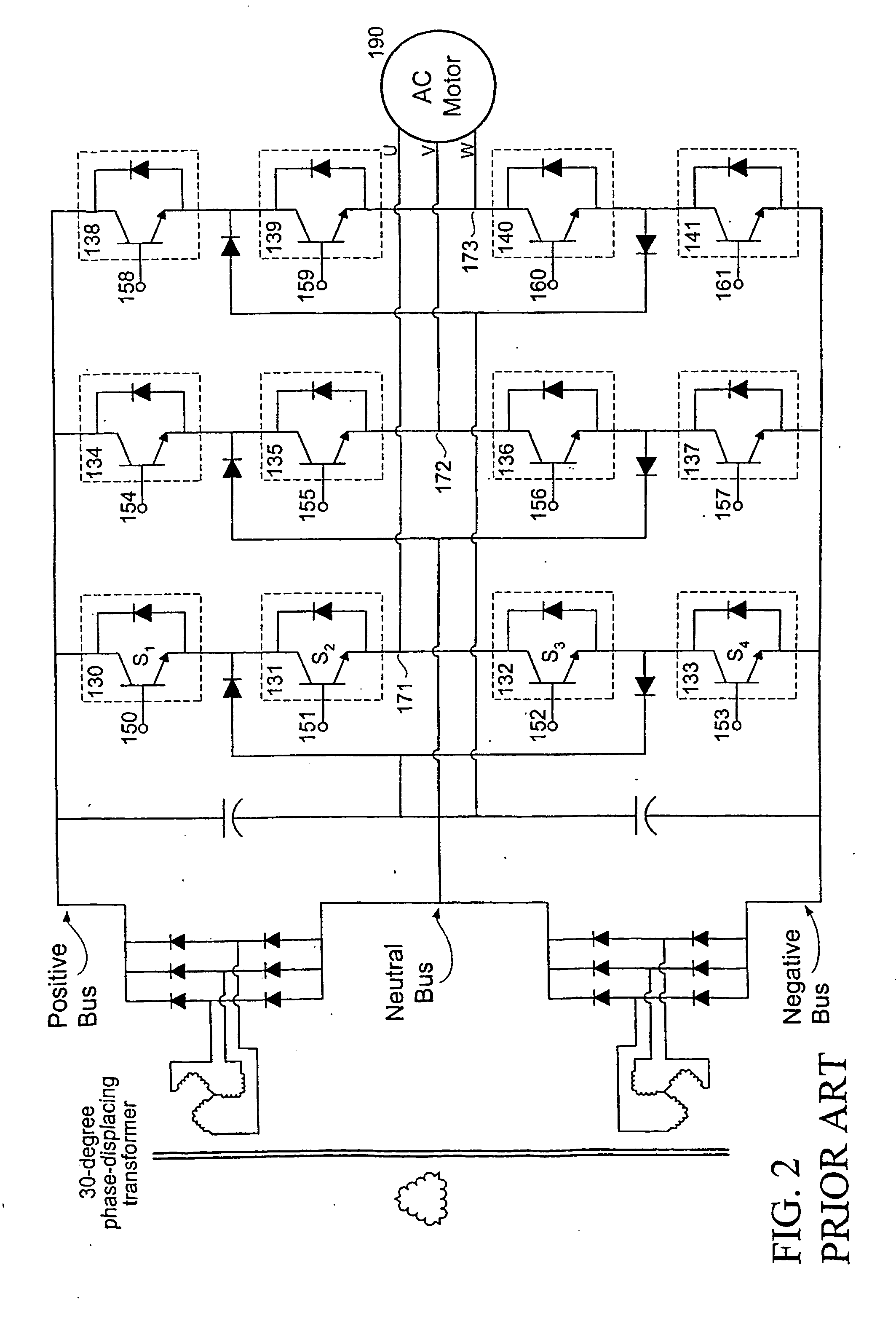Low voltage, two-level, six-pulse induction motor controller driving a medium-to-high voltage, three-or-more-level ac drive inverter bridge
- Summary
- Abstract
- Description
- Claims
- Application Information
AI Technical Summary
Benefits of technology
Problems solved by technology
Method used
Image
Examples
first embodiment
[0076] The first embodiment is a method for implementing this first variation of the invention. As illustrated in FIG. 5, the six modulated signals are converted into N time-coordinated signals (step 500), the N time-coordinated signals being used to control the N switches of a multiple-level inverter bridge (step 510). As illustrated, there is a three-phase, pulse-width modulated output. As explained above, it is required that when the six modulated signals are converted into N time-coordinated signals, for each branch b, never-less-than N / 6 of the time coordinated signals have a logical-off state.
[0077] Since the six modulated signals were originally intended to control three branches of two switches each (FIG. 1), the six modulated signals can be further characterized as being three pairs of modulated signals A1b and A2b. If these modulated signals were used to control a two-level inverter bridge, each pair would control one of the three branches of the two-level bridge. That is,...
second embodiment
[0104] the invention is an adapter circuit in accordance with the first variation of the invention, converting modulated signals A1b and A2b into time-coordinated signals S1b to S(N / 3)b. The adapter circuit is built from analog and / or digital circuits, and / or programed into a programmable logic device such as a Digital Signal Processor (DSP), a microcontroller, a microprocessor, or a Complex Programmable Logic Device (CPLD) in accordance with the procedures illustrated in FIGS. 5 to 16 and as discussed above.
[0105] For an analog implementation, any type of delay element can be used, such circuits being numerous, and well known in the art. One example is a timer circuit implemented to create a delay. Another example is a resistor and capacitor in series connected to a voltage comparator amplifier, as illustrated in FIG. 28. The amount of time delay is defined by the values of the resistor and the capacitor. The voltage comparator amplifier compares an analog voltage threshold to the ...
third embodiment
[0109] The third embodiment is an induction motor drive system implementing the first variation of the invention. The induction motor drive includes at least a two-level motor controller outputting signals for controlling a two-level inverter bridge, a multiple-level bridge having N≧12 switches arranged to form 3 branches, and an adapter circuit generating N time-coordinated signals for controlling the N switches of the multiple-level inverter bridge from the signals output by the two-level induction motor controller.
[0110]FIG. 18 illustrates signal flow within the drive system. The two-level induction motor controller 1800 outputs six modulated signals (A1b, A2b), which the adapter circuit 1810 converts into N time-coordinated signals. The N time-coordinated signals control the switches in the N switches in the multiple-level inverter 1820, which provides a three-phase output to an AC motor 1890. For examples of common configurations of the N switches of the multiple-level inverter...
PUM
 Login to View More
Login to View More Abstract
Description
Claims
Application Information
 Login to View More
Login to View More - R&D
- Intellectual Property
- Life Sciences
- Materials
- Tech Scout
- Unparalleled Data Quality
- Higher Quality Content
- 60% Fewer Hallucinations
Browse by: Latest US Patents, China's latest patents, Technical Efficacy Thesaurus, Application Domain, Technology Topic, Popular Technical Reports.
© 2025 PatSnap. All rights reserved.Legal|Privacy policy|Modern Slavery Act Transparency Statement|Sitemap|About US| Contact US: help@patsnap.com



